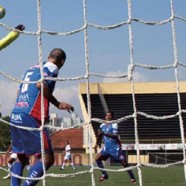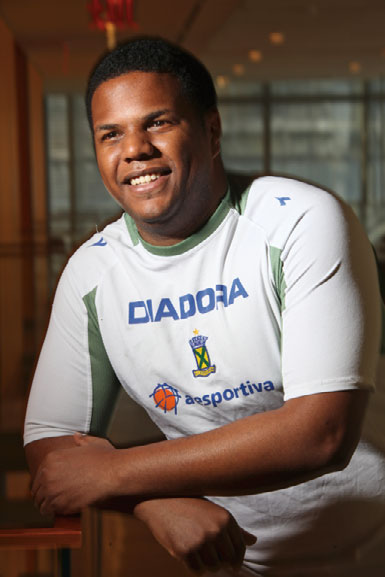
It was my first day of practice with Santo André and I sat quietly on the team bus, staring out the window as we rode to a practice center. I had no idea where we were going or what kind of soccer I was in store for. As the bus veered through the winding hills and favelas of São Paulo, one of Brazil’s largest cities, I wondered what was ahead of me.
Having graduated from Princeton in 2006, I was now in the second year of my quest to become a professional soccer player. I spent most of 2007 in San Francisco, playing in the United Soccer League’s Premier Development League, a minor-league circuit equivalent to Class AA baseball, and then working out for some lower-division clubs in England.
Now, I was in Brazil, in January 2008, thinking, realistically or not, that if I could stay focused and work hard and show some promise, I could have an entire soccer career in the hotbed of the sport. The worst case was that I would come home with some valuable credibility as a player and sign with an M.L.S. team for the 2008 season. I was ready for my adventure, even if I could barely speak a word of Portuguese.
Santo André was a second-division team that was hoping to recapture some of its recent history. In 2004, the club won the Copa do Brasil, a 64-team tournament composed of the top teams from all 26 of the South American country’s states. But now it was simply back to being stuck one tier down from the top, playing in a 15,000-seat stadium that consisted of concrete bleachers and had definitely seen better days.
I found a place to live right next to the stadium. Since many of my teammates had families, I found myself spending a lot of time by myself in the neighborhood, a busy area about 40 minutes south of downtown.
A two-lane highway ran two blocks east of the stadium, and you could hear the noise of its traffic while hanging around the stadium complex on a day when no game was scheduled. When there was a game, fans would sometimes park miles away and walk because there was not enough space nearby for parking.
Nor was there any room for practice fields, which meant every day was a bus tour, as we traveled to different locations around the city looking for somewhere where we could kick some balls around. Sometimes we would practice twice a day, in two places. The best field we practiced on had a surface that was all dirt, a welcome contrast to the bumpy, uneven grass we often encountered.
I was assigned to the reserve team, better known as the Profi B. At 24, I was one of the older players on a squad that had players as young as 18. Being a foreigner from an inferior soccer country had already presented a hurdle for me in Brazil, and my age did not make things easier. In a country where young players were often sold to create big paydays for their clubs, an older player was automatically less attractive. It would be one more obstacle to navigate.
When I got off the team bus for that first practice, I met the coach. To me he was known only as Barone. He had played professionally in Brazil in the 1980s, but now he had a pot belly, a slight limp and a scowl that rarely left his face.
I probably understood about half of what Barone said, as he would mumble instructions in Portuguese. To get by, I would usually follow what other players were doing and then wait for an extended break to get a more coherent explanation from the assistant coaches.
What I also did to learn the language was buy a biography of the English guitar player Eric Clapton in Portuguese and then spend nights reading it with the help of a Portuguese-English dictionary.
Victories and losses meant little to Barone—player development was the key issue—so he would jump on us for mistakes whether we were in a close game or winning 5–0. And the practices were always intense. Right away I knew I was in a different place when we broke into teams and Barone threw out what is known as a futsal ball. Futsal balls are smaller and have a restricted flight. With significantly less bounce, the ball stays on the ground and encourages more creativity.
I soon learned that this ball was a staple in training and that its size and density made everyone’s individual footwork stand out. As we graduated to using a standard ball, I began to feel the rhythm and flow for the game that Brazilians are renowned for. I quickly realized that I could do many of the simple things that my teammates could, but that the ease and comfort that they expressed on the ball made my movements seem almost robotic. I fought the game while they embraced it.
Still, from the first practice on, I was determined to have an impact. I walked to the local mall on my first day off and bought some inexpensive indoor shoes and an extra ball so I could put in extra work in the evenings. In the first month or so, I spent hours on mundane exercises like slamming a ball at a concrete wall and trying to comfortably trap the rebound.
Occasionally, youth players affiliated with Santo André—some as young as 12 or 13—would pass by, see me training and join in. One night, one of the youngsters came by and we spontaneously started working on free kicks. He was insistent that he had a better method than the one used by Real Madrid’s Portuguese star Cristiano Ronaldo and was determined to convince me.
We spent the next hour taking turns bending kicks at an imaginary target, and I was amazed by how enthusiastic he was about all the ways to strike the ball. The curiosity he had was startling. While I ran extra drills to sharpen certain movements, young Brazilians were always thinking of new moves that nobody had seen before. And because of that constant exploration, they never got tired of the game.
Many of the youth players lived in dormitories built into the east side of the stadium, with as many as four sets of bunk beds in one room. I spent my first month in Brazil talking with a lot of them and listening as they described their dreams of playing for a major European team. It quickly became clear to me that their overall mentality was different from players their age in the 26 Milton Magazine United States. They were not particularly interested in winning tournaments or trophies; they just wanted to find the quickest path to being a professional, preferably in Europe.
As a result, they had no real loyalty to Santo André; it was just the team they were currently playing for. Next week, it could be somebody else. Indeed, it seemed as if every week there was a new player moving into one of the rooms, while another would disappear.
As I became more comfortable with the language, I found that the best way to bond with people was to try to fill in their gaps about American culture.
I talked with our trainer, Jon, about our mutual love for the Boston Celtics, and how K.G., Kevin Garnett, was making a big impact on the franchise in his first year. At night, I had dance battles with one of our midfielders. I talked about hip-hop music with our assistant coach, Neir, who turned me on to Brazilian rap.
In the end, I played in five games for the Santo André reserve team, but never scored. Still, I was surprised by how comfortable I felt on the field. It helped, too, that our coach knew explaining the tactics of our defense to me in any detail was probably a lost cause. As a result, I was free to go out and just do my best. More than anything, I was seduced by the Brazilian mentality, which somehow allows players to take their soccer seriously while at the same time not taking it seriously at all. Win or lose, it was inevitable that halfway through the bus ride home somebody would turn his water bottles into drums and there would be singing all the way back to the stadium.
To me, the Brazilians approached the game with both curiosity and confidence. When I flew home in the summer of 2008, I felt I had graduated from a crash course. It led to a tryout with Major League Soccer, a stint with the reserve team of the San Jose Earthquakes, and then a chance to play in Trinidad until a hamstring injury intervened.
My professional soccer career was pretty much over. But my appreciation of Brazilian soccer is intact. Its compelling style was on display when Brazil’s men’s team played the United States and then Argentina in exhibition games. It was in the spotlight this summer, too, when Brazil competed in both men’s and women’s soccer in the London Olympics.
Some of you likely caught it on television or in person. I am thankful I got to see it up close.
–Adrian Melville ’02
Printed in the New York Times on May 17, 2012. Chester Higgins Jr. / The New York Times / Redux




